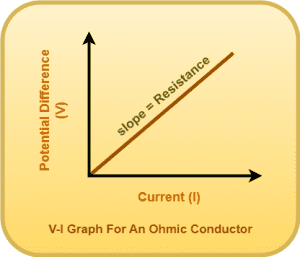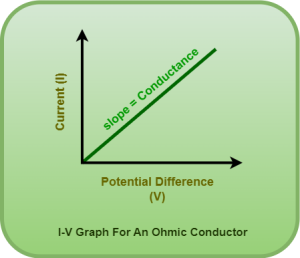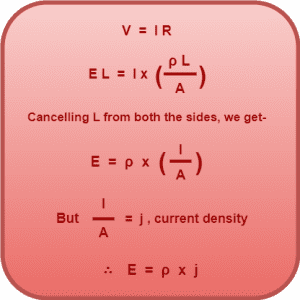Ohm’s Law-
On the basis of his experimental observations, a German physicist George Simon Ohm derived a relationship between electric current and potential difference. This relationship is called as Ohm’s law.
Ohm’s law can be stated as-
| The current flowing through a conductor is directly proportional to the potential difference applied across its ends provided the physical conditions like temperature, pressure, humidity, strain etc remains unchanged. |
Mathematically,
Potential difference ∝ Current
V ∝ I
or

where R is a constant of proportionality called as resistance of conductor.
Ohm’s Law Graphs-
The following graphs are plotted between the potential difference V applied across the conductor to the current flowing through it.
V-I Graph:
On comparing V = RI with y = mx, we conclude that-
- The graph between V (plotted on Y-axis) and I (plotted on X-axis) is a straight line passing through origin.
- The slope of V-I graph = resistance of conductor.

I-V Graph:
The equation V = RI can be written as I = (1/R)V.
On comparing I = (1/R)V with y = mx, we conclude that-
- The graph between I (plotted on Y-axis) and V (plotted on X-axis) is a straight line passing through origin.
- The slope of I-V graph = 1/R = G = conductance of conductor.

Vector Form of Ohm’s Law-
If E is the magnitude of electric field in a conductor of length L, then the potential difference across its ends is-

(Equation-01)
Also, we know the resistance of a conductor having length L & area of cross-section A is given by-

(Equation-02)
Substituting Equations-01 and 02 in the scalar form of Ohm’s law V = IR, we get-

As the direction of current density j is same as that of electric field E, we can write the above equation in vector form as-

Since ρ = 1 / σ, so the above equation can also be written as-

The above two equations represent the Ohm’s law in vector form.
Ohmic Vs Non-Ohmic Conductors-
Ohm’s law is obeyed by many substances under certain conditions but it is not a fundamental law of nature.
Ohmic Conductors |
Non-Ohmic Conductors |
| Ohmic conductors are those which obey Ohm’s law. | Non-ohmic conductors are those which do not obey Ohm’s law. |
| The resistance of ohmic conductors is constant at a given temperature. | The resistance of non-ohmic conductors is not constant even at a given temperature. |
| The resistance is independent of the current through the conductor. | The resistance of such conductors is current dependent. |
| For ohmic conductors, the linear relationship between voltage and current holds good. | For non-ohmic conductors, situations may be of types-
|
| Examples of ohmic conductors- copper, silver etc. | Examples of non-ohmic conductors- p-n junction diode, thyristor, GaAs etc. |
Limitations of Ohm’s Law-
Ohm’s law is not a fundamental law of nature.
- It is not applicable to unilateral networks which allow the current to flow in one direction. Such types of network consist of elements like diode, transistor etc.
- It is not applicable to non-linear elements like thyristor etc.
Test Your Concepts-
Next Article-
Get more notes & other study material of the Chapter Current Electricity.

